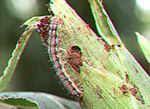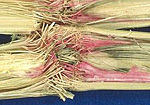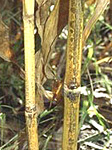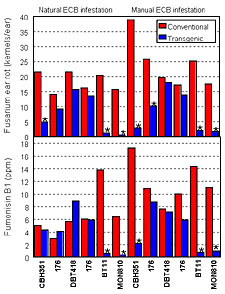Introduction
The recent approval and commercial release of genetically modified, insect-resistant corn hybrids represents the culmination of decades of biotechnology research. Many in agriculture felt that the investment in molecular biology research was finally starting to pay off, and the release of Bt corn was met with great enthusiasm. Crop producers and the agricultural industry rapidly accepted the technology and began to incorporate it into their crop production practices. Now, controversy over production and use of genetically modified crop cultivars has focused a great deal of public attention on Bt corn. A number of organizations and individuals have raised questions about the safety and ethics of Bt corn production, despite Environmental Protection Agency approvals that consider environmental impact, food safety, nontarget effects, and pest resistance. The controversy has been fueled largely by the reluctance of European consumers to accept genetically modified crops. Although Bt technology has fairly obvious benefits for corn producers and biotechnology companies, some consumers have found it difficult to perceive any benefit of Bt technology toward the consumer.
In the current atmosphere surrounding Bt corn production, the need for investigation into all potential risks and benefits of Bt technology is more critical than ever. Approval by EPA carries with it assurance that these products are safe, but additional data may be needed so consumers can make informed choices and convey their preferences to policymakers. One aspect of risk/benefit analysis is the influence that Bt technology may have on corn diseases and mycotoxin-producing fungi in corn.
Lepidopteran pests of corn and their interactions with pathogens
Insects affected by currently available Bt corn hybrids are in the order Lepidoptera, which includes moths and butterflies. The primary target species for Bt corn is
Ostrinia nubilalis, the European corn borer (ironically, the pest that induced the development of Bt corn was imported from Europe). Other Lepidopteran pest species that can be controlled or partially controlled by current Bt technology are corn earworm
(Helicoverpa zeae), common stalk borer
(Papiapema nebris), armyworm
(Pseudaletia unipunctata), and Southwestern corn borer
(Diatraea grandiosella). Currently available Bt hybrids are very effective against European corn borer (Rice and Pilcher, 1997), stalk borer, and southwestern corn borer, and they can reduce damage by armyworm and corn earworm, but they have not shown much benefit for controlling damage by black cutworm (Agrotis ipsilon) or fall armyworm (Spodoptera frugiperda) (Pilcher et al., 1997; Lynch et al., 1999).
Lepidopterans can influence the development of stalk rot and ear rot diseases in corn. In particular, Fusarium ear rot, caused by
F. verticillioides (syn.
F. moniliforme), F. proliferatum, or
F. subglutinans, and Aspergillus kernel rot, caused by
A. flavus, are often associated with insect damage to ears or kernels (Dowd, 1998; Smeltzer, 1958; Smith and White, 1988). Any of the major stalk rots can be associated with stalk tunneling (Bergstrom et al., 1997; Chiang and Wilcoxson, 1961; Christensen and Schneider, 1950), although the overall importance of insect tunneling in stalk rot development is a matter of some disagreement among plant pathologists (Dodd, 1997). |

European corn borer.
Click image for enlargment. 
Corn earworm.
Click image for enlargment. 
Southwestern corn borer.
Click image for enlargment.

Stalk tunneling.
Click image for enlargment. |
The associations between these insects and corn diseases result from several types of host-insect-pathogen interactions. One type of interaction is a vector relationship. European corn borer larvae carry spores of
Fusarium species from the plant surface to the surfaces of damaged kernels (Sobek and Munkvold, 1999) or to the interior of stalks, where infections are initiated. Viable spores can be found externally, internally, and in the frass of European corn borer larvae. Similar relationships exist between corn earworm or southwestern corn borer and
Fusarium or
Aspergillus spp. (Dowd, 1998). A second type of interaction is the formation of entry wounds for the fungi when larvae feed on stalks or kernels. Even when the larvae do not directly carry the fungi into the stalks, spores subsequently deposited on the wounded tissue are very likely to infect the plant. Additionally, root and stalk damage by insects causes stress that predisposes the plants to stalk rot development. For these reasons, management of these insects can play a major role in corn root and stalk rot management.
Importance of insect-mediated corn diseasesFusarium ear rot is the most common ear rot disease in the Corn Belt; it can be found in nearly every cornfield at harvest (Smith and White, 1988). The severity of this disease is usually low, but it can reduce yield and quality. The primary importance of this disease is its association with mycotoxins, particularly the fumonisins. |

Fusarium ear rot.
Click image for enlargment. |
Fumonisins are a group of mycotoxins that can be fatal to horses and pigs, and are probable human carcinogens (Munkvold and Desjardins, 1997). The importance of fumonisins in human health is still a subject of debate, but there is evidence that they have some impact on cancer incidence in some parts of the world (Marasas, 1995). Fumonisin concentrations in corn are or will be under regulatory scrutiny in many parts of the world (Miller, 1999). Symptoms of Fusarium ear rot are often highly correlated with ear damage by European corn borer and corn earworm larvae (Table 1) (Christensen and Schneider, 1950; Munkvold et al., 1999; Smeltzer, 1958). Several
Fusarium species can infect kernels without causing visible symptoms, but still affect grain quality and produce mycotoxins.
Table 1. Linear correlation coefficients among insect feeding damage, Fusarium ear rot, and fumonisin B1 concentrations in conventional and Bt hybrids from field trials in Story (1996 and 1998) and Boone counties, Iowa (1997). All coefficients were highly significant (
P < 0.0001).
|
Fusarium ear rot severity (kernels/ear) |
Fumonisin B1 (µg/g) |
|
1996 |
1997 |
1998 |
1996 |
1997 |
1998 |
|
Insect feeding severity (kernels/ear) | 0.66 | 0.86 | 0.81 | 0.50 | 0.69 | 0.76 |
|
Fusarium ear rot severity (kernels/ear) | | | | 0.69 | 0.76 | 0.73 |
Kernel rot caused by
Aspergillus also is associated with insect damage to ears (Dowd, 1998).
Aspergillus flavus and
A. parasiticus produce the most notorious mycotoxins in corn, the aflatoxins. The economic impact of aflatoxins has been greater than that of other mycotoxins in corn because aflatoxins can be passed into milk if dairy cows consume contaminated grain. As a result, the Food and Drug Administration has set action levels for unacceptable aflatoxin concentrations in corn. The action level (20 parts per billion) often is exceeded in corn grown in the southern United States, and occasionally is exceeded in corn grown in the north central United States.
The stalk rot complex comprises the most serious, widespread disease problem in corn. Yield losses occur as a result of premature plant death and lodging. Stalk rot-affected fields usually are damaged by more than one fungal species, but Gibberella stalk rot, caused by
Gibberella zeae, Fusarium stalk rot, caused
by Fusarium verticillioides (F. moniliforme), F. proliferatum, or F. subglutinans, and anthracnose stalk rot, caused by
Colletotrichum graminicola are the most frequently reported (Smith and White, 1988). The development of stalk rot is greatly affected by plant stress (Dodd, 1980) and may or may not be associated with insect damage. |

Kernel rot.
Click image for enlargment.

Gibberella stalk rot.
Click image for enlargment.

Anthracnose stalk rot.
Click image for enlargment. |
Diseases and mycotoxins in Bt corn
During the mid-1990’s, as Bt corn approached EPA approval, researchers in several states began to investigate how insect management with Bt corn influenced corn diseases that are associated with insect activity. In most cases, experiments have been conducted comparing disease and mycotoxin levels between Bt hybrids and "near-isogenic" conventional hybrids.
In these studies, differences among types of Bt genes (or Bt events) have become evident. All Bt events are not alike. Currently available Bt hybrids express either CryIA(b), CryIA(c), or Cry9C, all members of a group of delta-endotoxins originally produced by some strains of the bacterium
Bacillus thuringiensis. Table 2 shows some characteristics of currently available Bt events. The expression of Cry proteins in specific corn plant tissues is dependent on the gene promoter used in each transgenic genotype. Proprietary
cryIA(b) transformations BT11 and MON810 (YieldGard®) use a CaMV 35S gene promoter that results in season-long expression of CryIA(b) in all plant tissues, whereas
cryIA(b) transformation 176 (marketed as Knockout® and NatureGard®) uses a combination of two maize-derived, tissue-specific promoters: a phosphoenolpyruvate carboxylase promoter that results in gene expression only in green plant tissues, and a pollen-specific promoter. Kernel expression of CryIA(b) appears to be an important factor determining the amount of kernel feeding by European corn borer larvae and subsequently the intensity of
Fusarium infection.
Table 2. Bt events commercially available in the United States.
|
Bt event |
Trademark |
Cry protein |
Promoter(s) |
Expression |
Approved in EU |
176 | KnockOut, NatureGard | Cry1A(b | PEPC + pollen | Green tissue + pollen | Yes |
| BT11 | Yieldgard | Cry1A(b) | CaMV 35S | All tissue | Yes |
| CBH351 | StarLink | Cry9C | CaMV 35S | All tissue | No |
| DBT418 | BTXtra | Cry1A(c) | CaMV 35S | All tissue | |
| MON810 | Yieldgard | Cry1A(b) | CaMV 35S | All tissue | Yes |
Results of field studies have consistently demonstrated that hybrids containing the MON810 and BT11 Bt events experience significantly lower incidence and severity of Fusarium ear rot and yield corn with lower fumonisin concentrations than their non-Bt counterparts (Figure 1). Similar results have been obtained in studies conducted in Iowa, Illinois, and North Carolina (Dowd and Munkvold, 1999; ILSI, 1999; Munkvold et al., 1997; Munkvold et al., 1999). When conventional hybrids were subjected to high populations of European corn borers, Fusarium ear rot severity and fumonisin concentrations became elevated, often to levels considered unsafe for swine and horses. Levels considered safe for horses and swine are <5 ppm and <10 ppm, respectively. Safe fumonisin levels for humans are unknown (Munkvold and Desjardins, 1997).
Fusarium ear rot and fumonisin levels in MON810 and BT11 hybrids were uniformly low (usually less than 10% of the concentrations in the non-Bt hybrids) and they were unaffected by European corn borer populations. In hybrids with Bt events DBT418 and 176, there were no consistent differences between Bt and non-Bt hybrids. This is probably a result of the lack of kernel expression in event 176 hybrids and the generally poorer late-season corn borer control demonstrated by event DBT418 hybrids. Hybrids with Bt event CBH351 displayed ear rot and fumonisin levels similar to MON810 and BT11 hybrids. Over all hybrids, there are highly significant correlations among insect damage, Fusarium ear rot severity, and fumonisin concentrations (Table 1). |

FIGURE ONE.
Click image for enlargment.

Ear samples from a 1997 field trial.
Click image for enlargment. |
Field studies also have shown reduced kernel infection by A. flavus and lower aflatoxin concentrations in BT11 and MON810 hybrids compared with their non-Bt counterparts. However, these reductions have been less dramatic than those seen for fumonisins. Studies have been conducted in Iowa, Illinois, Mississippi, Texas, and other locations. In Iowa and Illinois, A. flavus infection and aflatoxin concentrations have typically been too low to discern any differences among hybrids. In contrast, aflatoxin concentrations in the Mississippi and Texas studies have been very high. Windham et al. (1999) reported that when plants were infested with southwestern corn borers, a BT11 hybrid had more than 75% reduction in aflatoxin compared with its non-Bt counterpart (5 ppb vs. 41 ppb). This is a significant result because the FDA action level for aflatoxin is 20 parts per billion (ppb). When plants were infested with southwestern corn borer and inoculated with A. flavus, aflatoxin concentrations in the BT11 hybrid were about 50% lower, but the concentrations were well above the FDA action level in both hybrids (290 and 650 ppb, respectively, for the Bt and non-Bt hybrids). Similarly, in Texas in 1998, a significant reduction in aflatoxin concentration was reported for BT11 and MON810 hybrids compared to the non-Bt hybrids, but aflatoxin concentrations were well above the action level in all the hybrids (J. Benedict, Texas A&M University, personal communication).
The relationship of insect damage to corn stalk rot is less clear-cut than the relationship to Fusarium and Aspergillus ear rots. Stalk rots often enter plants through the roots (Dodd, 1980); under these conditions, resistance to lepidopteran pests is unlikely to be of much benefit. However, some proportion of stalk rot incidence is related to stalk-boring insects and there is evidence for reduced stalk rot in Bt hybrids. In New York, Bergstrom et al. (1997) reported significant reductions in anthracnose stalk rot for hybrids with MON810, BT11, and 176 Bt events. In Iowa and Nebraska, results have varied among experiments. In Iowa fields that experienced considerable predisposing stresses and had little insect damage, stalk rot developed equally in Bt and non-Bt hybrids. Where European corn borer populations were moderate to high, significantly less stalk rot (primarily Gibberella) occurred in the Bt hybrids, and the effect differed among Bt events (Gatch and Munkvold, 1999). Reimers et al. (1998) reported that there were no differences in stalk rot between Bt and non-Bt hybrids in a 1997 experiment in Nebraska. We are continuing to investigate the relationships among European corn borers, stalk rot, and stalk strength in Bt hybrids.
Limitations to Bt corn benefits
Although the results described here support the utility of Bt hybrids for management of Fusarium and Aspergillus ear rots and stalk rots of corn, it should be emphasized that these diseases all require an integrated management approach involving other tactics. Although fumonisin and aflatoxin concentrations are typically lower in Bt hybrids compared with conventional hybrids, this might not be enough when conditions are very favorable for disease. In the southeastern United states in years favorable for severe ear rot, Bt hybrids can have levels of ear rot and mycotoxins similar to those in non-Bt hybrids. Both of these diseases and their associated mycotoxins can occur in kernels in the absence of insect damage because they have other pathways for infection. This is even more important for stalk rots, where the primary pathway for infection is independent of Lepidopteran feeding damage.
Another limitation of Bt corn hybrids is their spectrum of activity. Currently available events are very effective against European corn borer but not as effective against corn earworm and fall armyworm. In the southern United States, where aflatoxin problems are chronic, these species and southwestern corn borers are the primary lepidopteran pests feeding on corn ears. Damage to ears of Bt hybrids by these insects probably leads to
A. flavus and
F. verticillioides (F. moniliforme) infection and mycotoxin contamination.
Future directions
Bt hybrids can be an important tool in the integrated management of Fusarium and Aspergillus ear rots and corn stalk rots. New Bt hybrids now under development promise to exhibit more complete control of corn earworm and fall armyworm, and this should enhance their effects on insect-associated fungi. New events also are being developed for control of coleopteran pests such as corn rootworms (
Diabrotica spp.). Control of corn rootworms has the potential to reduce stalk rot by maintaining better root health and reducing physical damage to the roots where the stalk rot fungi can enter the plant. Coleopterans that feed on corn ears and silks, such as adult corn rootworms and sap beetles (family Nitidulidae) can contribute to ear rot (Dowd, 1998). If new transgenic hybrids are resistant to these insects, there could be further contributions toward mycotoxin management. Transgenic control of insects and diseases offers an alternative that is much more effective, consistent, economical, and environmentally sound than foliar insecticides. For example, in sweet corn for fresh market sales, 12-40 insecticide applications may be made in a single season to conventional hybrids for control of kernel-feeding insects and subsequent mold development. Even with currently available partial resistance to corn earworms in Bt hybrids, insecticide use can be drastically reduced (Lynch et al., 1999).
Debate surrounding the use of genetically modified crops should be based on an assessment of all risks and benefits that can be measured, including environmental impacts, livestock impacts, and potential human health threats. Available data show that Bt transformation of corn hybrids enhances the safety of the grain for livestock feed by reducing its vulnerability to mycotoxin-producing fungi. These mycotoxins also are likely to be detrimental to human health, so the lower concentrations of mycotoxins in Bt corn potentially have implications for food safety. Lower mycotoxin concentrations represent a clear benefit to consumers of Bt grain, whether the intended use is for livestock or human foods. Consumers and regulatory agencies should consider these factors in decisions regarding Bt corn use.
References
1. Bergstrom, G.C., Davis, P.M., and Waldron, J.K. 1997. Management of anthracnose stalk rot/European corn borer pest complex with transgenic Bt corn hybrids for silage production. Biol. Cultural Tests 12:13.
2. Chiang, H.C., and Wilcoxson, R.D. 1961. Interactions of the European corn borer and stalk rot in corn. J. Econ. Entomol. 54:850-852.
3. Christensen, J.J., and Schneider, C.L. 1950. European corn borer (Pyrausta nubilalis Hbn.) in relation to shank, stalk, and ear rots of corn. Phytopathology 40:284-291.
4. Dodd, J.L. 1980. The role of plant stresses in development of corn stalk rots. Plant Dis. 64:533-537.
5. Dodd, J.L. 1997. Gray leaf spot tolerance, Bt resistance, stalk rot and yield of corn. Professional Seed Research, Inc. February 4, 1997.
6. Dowd, P.F. 1998. Involvement of arthropods in the establishment of mycotoxigenic fungi under field conditions, pp. 307-350 in Mycotoxins in Agriculture and Food Safety (Sinha, K.K., and Bhatagnar, D., eds.) Marcel Dekker, NY.
7. Dowd, P.F., and Munkvold, G.P. 1999. Associations between insect damage and fumonisin derived from field-based insect control strategies. Proc. 40th Annual Corn Dry Milling Conf., June 3-4, 1999. Peoria, IL.
8. Gatch, E.W., and Munkvold, G.P. 1999. The role of transgenic Bt hybrids in the management of the maize stalk rot complex. Proc. 111th Session, Iowa Acad. Sci., April 23-24, 1999, Ames, IA.
9. ILSI Health and Environmental Sciences Institute. 1999. An evaluation of insect resistance management in Bt field corn: a science-based framework for risk assessment and risk management. ILSI Press, Washington, DC.
10. Lynch, R.E., Wiseman, B.R., Plaisted, D., and Warnick, D. 1999. Evaluation of transgenic sweet corn hybrids expressing CryIA(b) toxin for resistance to corn earworm and fall armyworm (Lepidoptera: Noctuidae). J. Econ. Entomol. 92:246-252.
11. Marasas, W.F.O. 1995. Fumonisins: their implications for human and animal health. Natural Toxins 3:193-198.
12. Miller, J.D. 1999. Reducing the impact of mycotoxins on the agricultural economy: A perspective on regulation. http://www.scisoc.org/meetings/abstract/1999/sp99ab19.htm APSNet Publication P-1999-0118-SSA.
13. Munkvold, G.P., and Desjardins, A.E. 1997. Fumonisins in maize: can we reduce their occurrence? Plant Dis. 81:556-565.
14. Munkvold, G.P., Hellmich, R.L., and Rice, L.G. 1999. Comparison of fumonisin concentrations in kernels of transgenic Bt maize hybrids and non-transgenic hybrids. Plant Dis. 83:130-138.
15. Munkvold, G.P., Hellmich, R.L., and Showers, W.B. 1997. Reduced
Fusarium ear rot and symptomless infection in kernels of maize genetically engineered for European corn borer resistance. Phytopathology 87:1071-1077.
16. Pilcher, C.D., Rice, M.E., Obrycki, J.J., and Lewis, L.C. 1997. Field and laboratory evaluations of transgenic Bacillus thuringiensis corn on secondary Lepidopteran pests (Lepidoptera: Noctuidae). J. Econ. Entomol. 90:669-678.
17. Reimers, C.I., Clark, T.L., Kamble, S.T., and Foster, J.E. 1998. Relationship of European corn borer and stalk rots in Bt and near isoline non-Bt maize hybrids in southeastern Nebraska. (Abstr.) 1998 Entomol. Sci. Am. North Central Branch Abstract D-7.
18. Rice, M.E., and Pilcher, C.D. 1997. Perceptions and performance of Bt corn. Pp. 144-156 in Proc. 52nd annual Corn & Sorghum Research Conf., Dec 10-11, 1997, Chicago, IL.
19. Smeltzer, D.G. 1958. Relationship between Fusarium ear rot and corn earworm infestation. Agron. J. 50:53-55.
20. Smith, D.R., and White, D.G. 1988. Diseases of corn, pp. 701-766 in Corn and Corn Improvement, Agronomy Series #18 (3rd ed.) (Sprague, C.F., and Dudley, J.W., eds.) ASA-CSSA-SSSA, Madison, WI.
21. Sobek, E.A., and Munkvold, G.P. 1999. European corn borer (Lepidoptera: Pyralidae) larvae as vectors of
Fusarium moniliforme, causing kernel rot and symptomless infection of maize kernels. J. Econ. Entomol. 92:503-509.
22. Windham, G.L., Williams, W.P., and Davis, F.M. 1999. Effects of the southwestern corn borer on Aspergillus flavus kernel infection and aflatoxin accumulation in maize hybrids. Plant Dis. 83:535-540.
